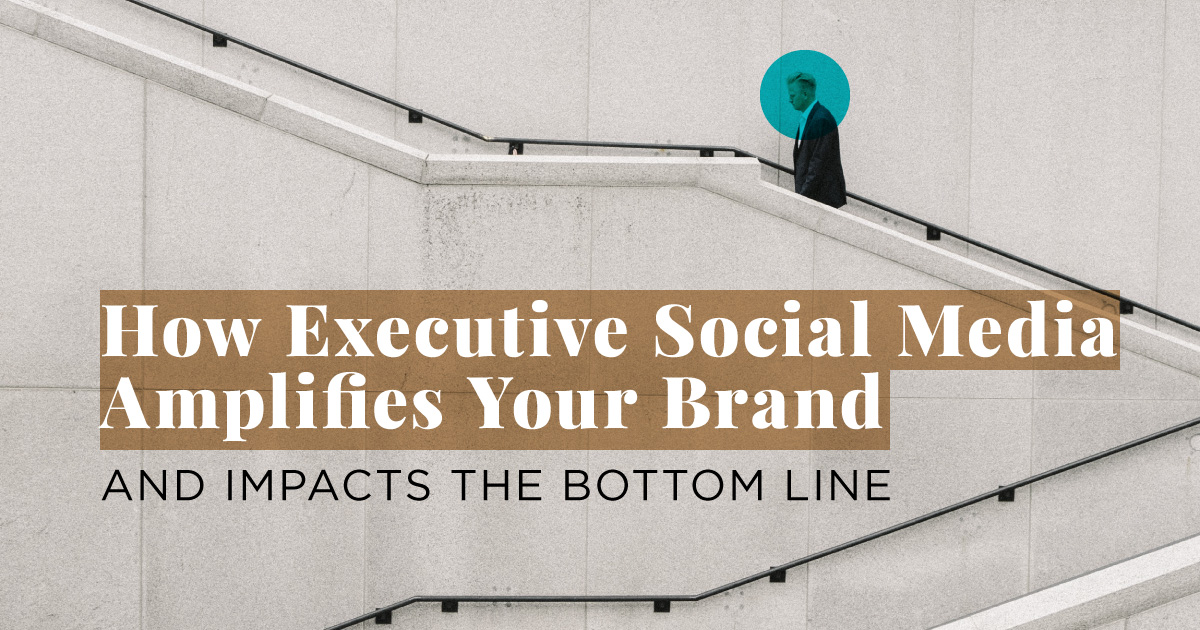Why Executives Need to be on Social Media
Social media for executives — it truly impacts the bottom line. Recent data is showing a compelling reason for CEOs and their teams to look at social media more seriously. Millennials lead the charge on this trend, but they are not the only ones looking to social media and the web to better understand the brands they buy from and the companies they work for – focusing on the leaders that represent them.
“Consumers are looking to social media and the web to better understand the brands they buy from and the companies they work for – focusing on the leaders that represent them.”
Millennial Decisions are Fueled by Online Research
Millennials are now a key part of the workforce, meaning that they are both potential talent and potential customers for your brand. These millennials often turn to social media to learn more about brands and what they stand for, from company culture to the value the company is creating in the world to social causes it’s contributing to. Having an influential executive’s voice as part of the conversation is important in gaining both their attention and their trust.
Millennials grew up online and are very much tuned into social media channels, and they use the internet and social media as a source of information for all decisions they make, including where to work and where to buy. However, more interestingly, they are not just turning to the brand’s official properties. They are also looking at key company leaders to get a sense of the company’s vision and values, while also looking at the CEO’s social media properties to see what they are talking about and the ideas they are sharing.
Positioning Leaders Online
Most senior executives do not yet have a strong social presence, particularly CEOs. Only 39% of CEOs have any social media presence at all. Why is it that there are so many brands who concentrate on their branded social media accounts, and yet often neglect the account of the face of the brand itself? It’s usually a combination of factors, from the executive’s lack of understanding of how and why to use social media, to a lack of time to dedicate to it given other priorities. Perhaps in some cases, it’s also a hesitance and risk aversion to having such a public, real-time voice.
As leaders consider the digital presence they want to create, B2B and B2C executives typically take slightly different approaches. Executives in business-to-business (B2B) industries like consulting, architecture, engineering, law, financial services and technology, generally have a common goal with their digital presence: to become a credible thought leader in their industry and an inspiration to prospective talent. Attracting the eye of prospective customers and, in some cases, investors is also often an important goal. Executives in business-to-consumer (B2C) industries like retail, consumer apps, and consumer packaged goods generally want to position themselves as an inspirational leader and use their social profile to convey key cultural values, brand benefits and differentiators and the social good the company is doing to prospective talent and customers.
Why Not Just Focus on the Brand?
If you’re still not convinced of the value of how social media for executives can lend to brand objectives, then we’ll let the data speak for itself.
It started with third-party reports and articles that we saw over the last year showing that people were more likely to engage with a leader than the brand itself. And while we’d also begun to observe this anecdotally in working with our clients, we set out to prove it ourselves with data.
The Research
We looked at more than one thousand profiles on LinkedIn, focusing on executives, leaders and brands, and created 3 tiers (low, medium and high) based on the size of their respective followings. We defined the low tier as under 10,000 followers, the medium tier as between 10,000 and 50,000 followers, and the high tier as more than 50,000 followers.
We then examined the rate of engagement, defined as likes and comments per post per number of followers. This allowed us to eliminate variables such as posting frequency and number of followers available to engage, which can differ substantially, even within each of the tiers we looked at. We wanted to focus on active LinkedIn accounts and defined this as a minimum of about 2 posts per week or 8 posts per month, as we also noticed that accounts with lower posting frequencies exhibited a high degree of variability in engagement rates.
Across all tiers we saw leaders outperform companies significantly in terms of engagement. We are continuing to collect data across all three tiers and look forward to sharing our results and findings periodically. We had the largest dataset for the low tier, so want to focus on findings for these leaders and brands with up to 10,000 followers. First, we found that engagement rates were higher for both leaders and brands at lower follower levels (<10,000), and generally decreased as the number of followers increased. Most importantly, for this tier we found that executives and leaders outperformed companies on engagement, defined as engagements per post, per follower, very significantly.
We found that executives and leaders outperformed companies on engagement, defined as engagements per post, per follower, by over 320%.
Within each follower tier, top performing leaders and executives were able to achieve significantly higher engagement rates than the top performing companies in the same tier. This suggests that some leaders are really effectively engaging their audiences and doing so at a rate many multiples higher than brands with a similar number of followers. We are launching another study to dive deeper into some of the drivers of particularly strong performance on LinkedIn and look forward to reporting on the results. An initial look at some of the variables indicates that consistent posting appears to be an important factor and tends to lead to overall higher engagement rates, even when looking at engagement per post.
So Why Do Leaders Outperform Brands on LinkedIn?
There are a number of reasons we believe we see this clear pattern of outperformance from leader and executive profiles over brand profiles.
“Content shared alongside a unique perspective feels more authentic when coming from an individual leader.”
First, content shared alongside a unique perspective feels more authentic when coming from an individual leader. It is very clear that the perspective is theirs, and that perspective often speaks to their experiences and values, particularly those that are top of mind for that leader at that time. When that same content and perspective is shared by a brand, however, it is unclear whose voice and perspective is being portrayed. The perspective is presumably speaking to the company or brand’s ‘corporate values,’ but there is always a sense that the ultimate goal of brand content is to market or sell something to you, whether that’s a product or service to prospective customers, or company culture and values to prospective employees.
Second, social media algorithms usually give higher preference to content coming from individuals over brands. Because of this, a leader is likely to get more impressions per post per follower than a brand, creating additional opportunities for engagement.
Third, people in the leader’s network, whether they’re other executives, ex-colleagues, fellow board members, employees, investors or fellow thought leaders and influencers in their field, are more likely to engage with that content because they know the leader and it’s relevant to themselves and their audience. When someone engages with a leader’s content, it’s then served to their own connections (regardless if those individuals follow the leader’s profile), creating a larger pool of relevant exposure and subsequently driving further engagements.
And fourth, others in the industry may also apply the principle of reciprocity (whether knowingly or subconsciously), engaging with interesting content from people they know, and therefore encouraging that person to do the same with their content. This is more true with individuals than with brands, and influencers seem to be much more likely to engage with key leaders who they also see as influencers versus engaging with a brand’s content, because they don’t necessarily want to endorse a particular company in the industry.
Social Media For Executives How-To: Getting Started
If you’re just getting started on social media, or you have dabbled and question the value and strategy behind what you’ve done to date, there are a few general principles you’ll want to keep in mind in order to get a strong start with your refreshed digital presence.
-
- Stand out
In order to stand out from other influencers in the industry, it is absolutely necessary for thought leaders to create a strong positioning and distinct voice. Defining this identity will initially take some time and research to understand the nuances of the industry, audience and competition.If you find it difficult to stand out from other thought leaders, consider focusing on a smaller niche, especially as you get started. It will be challenging to compete with already established thought leaders in larger industries and thought spaces, so narrowing your scope to an industry segment or sub-space will consequently narrow down your competitors and allow you to stand out as a deep expert. For example, rather than the broad industry of ‘content creation’, the more niche industry of ‘video content creation for Instagram marketing’ may yield more opportunities.
- Stand out
-
- Become a valuable resource
This distinct voice and identity must also be rooted in substantial and insightful content. Thought leadership is not about surface-level chatter, but rather about deep insight and thoughtful perspectives. This means developing a steady cadence of owned long-form content to be shared and amplified on social media, alongside expert commentary on industry news and relevant 3rd-party articles.This owned content can take a variety of forms, such as blogs, white papers, and short commentary pieces about recent events in your industry. All these reports give you an opportunity to demonstrate your expertise and build your credibility. However, unsurprisingly, the most important content pieces for a thought leader are the ones that share their own deep thoughts and expertise. Pieces that showcase the unique perspective that you’ve already carefully cultivated are the most valuable tool that you can use. These pieces can be opinions on recent events, or even just sharing an experience you’ve had that others may find useful.
By creating useful and engaging content, you will become a valuable resource for others in your industry, and by encouraging interaction from your followers, your platform will become a place they go to share their own knowledge and experiences. The advice and ideas you share and the conversations you initiate will have a hand in shaping the next generation of experts in your industry. They will look to you for guidance, inspiration, and possibly even work.
- Become a valuable resource
- Get active and stay active
Once you have a strong voice and valuable content that sets you apart from your competitors, you need to get active on your social media platforms. With all the initial research you’ve already done, locate the top influencers and follow them across platforms. In this way, you can build your network and begin getting your profile on the industry’s radar.However, you must do more than just follow these accounts. Engage with these accounts to insert yourself into the conversation and to increase your visibility. Like, share, and comment on quality posts. Encourage your followers to share their thoughts about your posts, and then respond to them to show you value their participation in the conversation. When you engage with others on social media, you gain exposure from their followers and even indirectly boost your own SEO. Joining groups on social media will also increase your visibility and help connect you to relevant followers, other influencers and potential partners and customers.
But First… Set Your Social Media Objectives
Before jumping into a social media program, it’s critical to start with a strong social media strategy, rooted in the executive’s objectives and interests. These key objectives should encompass their goals as a leader, their business/brand’s objectives (particularly the ones they are focused on contributing to), and their personal goals, including social causes they care about.
With all of these factors in mind, we can define the metrics that best measure the success of the program. For some executives, the most important metrics may be reach and engagement to determine the relevance of their content. When content reaches a large audience of individuals who also choose to engage, it’s a fairly sound indication that the content is resonating. For other executives, success may be determined by comments and driving conversation around specific topics. And for others still, it may be most important to drive traffic back to their blog or brand’s website where there’s an opportunity to explore additional insightful content and how the organization adds value. The list doesn’t end there. Additional objective-based metrics might include LinkedIn inquiries, media requests, speaking engagements, and more.
Optimizing your Social Media Profiles
With a clear set of objectives and KPIs laid out, profile optimization sets a strong foundation and ensures the executive is best positioned to be found through search and to appear credible when a user is interested in learning more or getting in touch.
Of course, start with the basis, like a professional, recent photo, a header image that makes your profile stand out and a custom LinkedIn URL. Updating your experience with at least your last 3 positions and education with all post-secondary schooling, plus a succinct and compelling summary is the next step. Adding location, industry, and skills can help make your profile more searchable for relevant leads and talent. And finally, adding accomplishments and recommendations add weight and credibility to your profile.
Interplay Between Brand and Leader
While each of the brand and leader social properties will be valuable in their own right and could standalone, there are opportunities for each to help amplify and complement the other.
One key example is paid amplification of posts. LinkedIn currently only allows companies to create ad accounts, so in order to sponsor a leader’s content, it must be done through the company page, mentioning the executive and linking to the executive’s article.
There are also opportunities to engage with each other’s content. Another note is that companies cannot share users’ content, so instead, the company can like a leader’s post, and also a write post mentioning the leader and linking to an article they wrote (and optionally sponsoring this post).
The leader can, in turn, share posts or articles posted by the company with their personal perspective or comment layered on top. They can also like and comment on posts or articles posted by the company.
We recommend coordinating the leader and brand content calendars, if possible, so that there are opportunities to add to and complement each other’s content through sharing and commenting, without having any feed appear too heavy on a particular topic (especially if the core content is the same). For example, you don’t want the leader and executive feeds to appear almost identical or have a homogeneous stream of very similar posts/activity on the executive’s profile due to sharing, liking and commenting on the company post, plus posting their own very similar posts all within a short time period.
“Part of the benefit of leveraging executives and leaders on social media is putting a human voice behind important messages and making them more authentic through values-oriented content.”
The executive’s profile can and should also incorporate some more diverse content, including things like leadership, culture and values topics they personally care about and perhaps social causes they are personally involved in or involved in through the company. Their personal perspective, personality and values should shine through and will be perceived differently than if the brand shared this content, because it is coming directly from the leader and will be associated with them personally. This is part of the benefit of leveraging executives and leaders on social media, putting a human voice behind important messages and making them more authentic through values-oriented content.
To learn how social media for executives can impact your business’ bottom line, click the button below to speak with one of our social media experts. Follow Influential Executive on Instagram for executive spotlights, social media stats, and more.
href="#" data-color-override="false" data-hover-color-override="false" data-hover-text-color-override="#fff">Learn about social media for executives!


